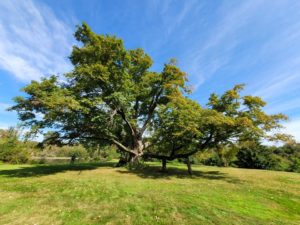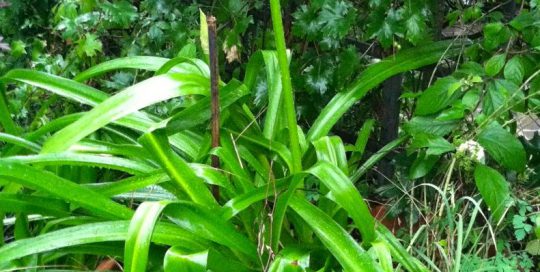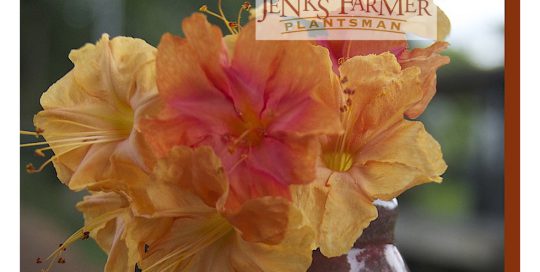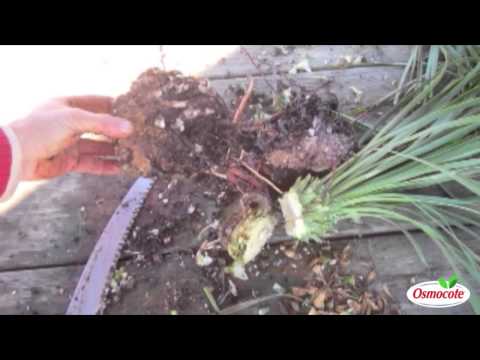Tree Donation for Tornado Victims
Views: 5594

I get a little choked up thinking about the tree donation.
Saturday, I didn’t let myself cry, but lots of people did. Tornado victims, a month later, gathered at a tree giveaway. I was there to help people decide what kind of tree they needed. EVERY person who I talked to started off with, “I lost 50 trees” or “I had 34 stumps ground up,” or such. EVERY person.
Then a few people looked around at the 1,000 trees and cried.
A combination of gratitude and grief. A start to healing and starting over? Solace from plants and the idea of gardening.
All trees for the Redcliffe Plantation tree donation were donated by:
– www.nurseriescaroliniana.com
– www.grandifloragrown.com
– Carolina Landscape Supply
Late May Garden Checklist
Today’s work notes came from gardening with Momma on Saturday. On Sunday, Tom and I gardened at our house. Monday, I was in the garden, in the rain in Lake City, and today, I’ll be in a tiny Charleston garden!
With all the rain so far, you probably need to cut back shrubs that are growing too much. Callicarpa, which I cut back every winter was already over 5 feet tall, so Saturday, I cut in back to about one foot. It would have been 9 feet tall by summer!
If you have four oclocks, pull up the seedlings that sprout just about everywhere. The can choke a rosemary or rose if you let them go.
Cut old flowering stalks and seeds off Crinum bulbispermum. (Surely you have numerous crinums by now!)
Try planting squash seeds among your perennials. The great big leaves are really dramatic in a perennial border.
Spread donkey poop on some tropicals, WHAT? You dont have donkeys? (We just got two dwarf donkeys on at the farm in Beech Island.) Actually, tropicals will appreciate ANY kind of poop, compost or manure.
And if youre still standing, divide those amaryllis bulbs that finished flowering a few weeks ago and cut back any spiderwort (Tadescantia) that has gone on.
Looking Good Now
Opuntia ellisiana (Spineless Cactus)
At Moore Farms we grow these spineless ones all over the garden especially in borders with boxwood and spiderwort. But we have many others that have orange, red, or yellow flowers. The best two are:
Opuntia Santa Rosa. A strong, compact grower with fat purple pad–slabs that can grow to 2 feet long by 10 feet wide. It has no thorns or bristles and can grow to 6 high and 6 wide in a few years.
Opuntia Morning Star. This dwarf has bright yellow, star-like flowers with a deep orange center and provides year-round interest. It can spread 3 to 5 feet wide in a season with small but showy bright green slabs. It is spines but with tiny prickles. Get it from www.verygoodplants.com
Spigelia Marilandica Indian Paint Brush
This incredible plant may start slow as it did at Moore Farms, but it reaches 3 x 3 in just a few years. With simple 2 trumpets that stand straight up on 15 to 18 stems, this one is bi-color with ruby red flowers and yellow blooms late spring through summer. Put it in light shade with medium water and it is low maintenance. We took cuttings from Hayes Jackson of one whose throat is cream color with thin red stripes about which my colleague, Ethan Kauffman, says, it is somewhat reminiscent of an after-dinner mint.
Salvia farinacea Henry Duelberg
This was found on a grave in Texas by Greg Grant. I grow this in the Charleston garden where it presents as absolutely luxurious and is totally evergreen. Both in Charleston and at Moore Farms, this beauty flowers for months with indigo spires that reach 4 feet tall. Full sun and well-drained soil will ensure that you probably will have to cut it back from growing too big!
Hydrangea arborenscens Annabelle
3-5 feet tall and spreads 4-6 feet. From this week, unti to September it produces wondrous symmetrical rounded heads of pure white blooms that can be 8-12 inches across,– well you have to cut it off later but it does flower again.. Grow this one in part shade with medium water. It is totally INTOLERANT of drought. Cut to ground in July and in January.
Dichromena colorata
This short, upright sedge with drooping leaves grows throughout our wet areas at Moore Farms. Ethan Kauffman describes it as elegant, carefree and long flowering. It is a star in the midsummer natural garden. and looks great with Stokesia.
Stokesia laevis Omega Skyrocket
6-8 inch evergreen basal leaves flowers on erect stems that usually are 1-2 feet tall. The flowers are white to pale blue to brilliant purple and look like shaggy cornflowers 3-4 inches across. Remove the spent flower stalks later. And remember, even wetlands plants can get TOO MUCH WATER, especially in the winter.
Meet Jenks Farmer
Jenks's Recent Posts

Beans: A Nurse Crop for Perennials








